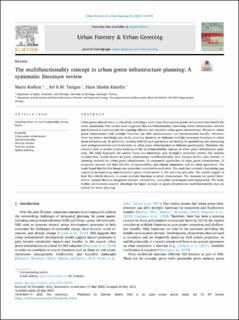| dc.contributor.author | Korkou, Maria | |
| dc.contributor.author | Tarigan, Ari Krisna Mawira | |
| dc.contributor.author | Hanslin, Hans Martin | |
| dc.date.accessioned | 2023-12-21T12:47:47Z | |
| dc.date.available | 2023-12-21T12:47:47Z | |
| dc.date.created | 2023-06-05T22:20:50Z | |
| dc.date.issued | 2023-05-29 | |
| dc.identifier.citation | Urban Forestry & Urban Greening. 2023, 85 . | en_US |
| dc.identifier.issn | 1618-8667 | |
| dc.identifier.uri | https://hdl.handle.net/11250/3108602 | |
| dc.description.abstract | Urban green infrastructure is critical for providing a wide range of ecosystem goods and services that benefit the urban population. Past studies have suggested that multifunctionality concerning urban infrastructure services and functions is a prerequisite for targeting effective and impactful urban green infrastructure. Moreover, urban green infrastructure with multiple functions can offer socio-economic and environmental benefits. However, there has been a knowledge gap in the planning literature to elaborate multiple ecosystem functions in urban green infrastructure. In particular, existing methods and approaches are lacking for quantifying and monitoring such ecological services and biodiversity in urban green infrastructures at different spatial scales. Therefore, this research aims to review studies focusing on the multifunctionality concept in urban green infrastructure planning. The study highlights the current status and knowledge gaps through a systematic review. Our analysis revealed that current studies on green infrastructure multifunctionality have focused on five main themes: 1) planning methods for urban green infrastructure, 2) assessment approaches of urban green infrastructure, 3) ecosystem services and their benefits, 4) sustainability and climate adaptation, and 5) urban agriculture. The study found that the five themes are somewhat connected to each other. The study has revealed a knowledge gap regarding incorporating multifunctional green infrastructure in the planning principle. The results suggest at least five critical elements to ensure multiple functions in urban infrastructure. The elements are spatial distribution, optimal distance, integrated network, accessibility, and public participation and engagement. The study further recommends research directions for future analysis on green infrastructure multifunctionality that are critical for urban planning. | en_US |
| dc.language.iso | eng | en_US |
| dc.publisher | Elsevier GmBH | en_US |
| dc.rights | Navngivelse 4.0 Internasjonal | * |
| dc.rights.uri | http://creativecommons.org/licenses/by/4.0/deed.no | * |
| dc.title | The multifunctionality concept in urban green infrastructure planning: A systematic literature review | en_US |
| dc.type | Peer reviewed | en_US |
| dc.type | Journal article | en_US |
| dc.description.version | publishedVersion | en_US |
| dc.rights.holder | © 2023 The Author(s) | en_US |
| dc.source.volume | 85 | en_US |
| dc.source.journal | Urban Forestry & Urban Greening | en_US |
| dc.identifier.doi | 10.1016/j.ufug.2023.127975 | |
| dc.identifier.cristin | 2152085 | |
| dc.relation.project | HK-dir - Direktoratet for høyere utdanning og kompetanse: UTF-2020/10061 | en_US |
| dc.source.articlenumber | 127975 | en_US |
| cristin.ispublished | true | |
| cristin.fulltext | original | |
| cristin.qualitycode | 1 | |

